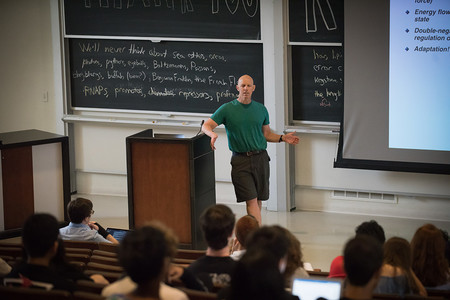As a gaggle of wide-eyed elementary school students crowd in for a view, first-year geophysics graduate student Celeste Labedz plunges her gloved hands into a basin overflowing with carbon dioxide fog.
With the children's help moments earlier, she had combined ingredients including water and dry ice to demonstrate how comets form. Now she pulls out the finished product: a fist-sized chunk of ice flecked with dirt and trailing streamers of white mist.
"Whoa!" one student cries. "Can we make another one?"
Labedz's visit to Field Elementary School in Pasadena on May 18 was part of the Science Night program that brings more than 30 Caltech volunteers—undergraduate, graduate, and postdoctoral scholars in physics, chemistry, biology, geology, astronomy, and engineering—to conduct science demonstrations for students at 11 schools across Pasadena and the San Gabriel Valley.
Started in 2013, the program originally targeted three area schools, but grew rapidly as parents and teachers spread the word about the events, and more schools invited Caltech to partner with them, says Mitch Aiken, associate director for educational outreach in Caltech's Center for Teaching, Learning, and Outreach.
Aiken says the program helps expand Catech's community involvement and provides benefits not only to local schools and their students, but also to the Institute and its students. "Through these events, our students and researchers are contributing to elevating overall science literacy while improving their own ability to explain complex topics to diverse audiences. That's critical to their success as they prepare for careers in industry, research, and academia."
More than 200 parents and students attended the recent event, which also featured hands-on demonstrations of gyroscopes, super-cooled magnets, and gravity-wave detectors.
"Many parents and students told me this was the best night of the year," says Daniel Bagby, principal of Field Elementary. "The presenters were so passionate about their field—and it was contagious. Students wanted to show me what they were learning and the sheer joy they were experiencing was truly palpable."
Arian Jadbabaie, a first-year physics graduate student who says he volunteers for Science Night about twice a month, spent the evening at Field demonstrating how gyroscopes work. Having visitors stand atop a spinnable disk, he invited them to grip a bike tire by handles attached to the sides its center axis. With the wheel spinning, participants tilted it right and left and suddenly found themselves turning on the disk, frequently prompting surprised laughter.
"My favorite part of the demonstrations is the look of amazement on the kids' faces when they see how the world is so much stranger than what they've seen or imagined," he says. "In those moments, I feel like I'm on the same level as they are, regardless of what additional technical knowledge I might have."
Taking a break from her comet-making demonstration, Labedz agrees: "When kids are excited about what they're hearing, you can see it. Sometimes they can't keep it to themselves and start bouncing around. It's awesome to see that learning can have that kind of effect on a kid."



















